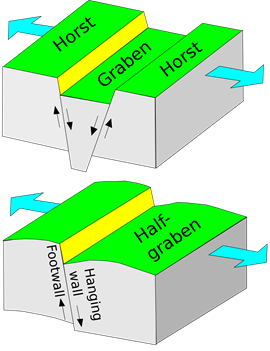Vale of Eden, Cumbria
The Vale of Eden is located in Cumbria in Northwest England and follows the course of the River Eden. In geology, the Vale is described as an extensional rift basin because of the tectonic processes that controlled its formation. This site is a classic example of the landscapes and geomorphological features caused by rifting.
The Vale of Eden separates the Cumbrian Mountains of the Lake District from the northern Pennines. It was formed by stretching and extension of the earth’s crust, a process called rifting, which is controlled by plate tectonics. The Vale is a small north-south trending fault-bounded basin that has a half-graben geometry. The escarpment along the SW flank of the Cross-Fell range, which abruptly terminates the northern Pennines, essentially lies along the fault scarp. So the landscape reflects the underlying geology.
| |
 |
| |
Geological concept of grabens and half grabens:
© Aymatth2
|
Prior to the rifting episode that created the basin, the continents were joined together to form the supercontinent Pangaea, which was a single landmass straddling both hemispheres. The area that is now the UK was located just north of the equator. The supercontinent later began to stretch apart – and the Vale of Eden basin has captured this process, frozen in time.
The Vale of Eden is part of the Pennine Fault System that forms the southwestern boundary to the Pennines in Cumbria. It was formed as a normal fault system (see the Geological Society animation on how normal faults are formed) during rifting in the Permian period (~299 to 252 million years ago). The space created by down-faulting was infilled by sediments. The types of sediment we find in these settings depends on the environment of rifting – whether it’s continental or under water. The rocks of Permo-Triassic age exposed in the Vale of Eden include aeolian (wind-deposited) sediments. These sandstones contain sand dunes pointing to a desert as the environment of deposition. The presence of sediments laid down in a desert environment in northern England is additional evidence for plate movement, and the continents that ride upon them, since these aeolian deposits could not have been laid down in an environment of deposition found in modern-day UK.
Podcast: Listen to Cynthia Ebinger, Chair in Geology at Tulane University, on the tectonics of the Vale of Eden and how it relates to the East African Rift Valley
Twinned with: East African Rift Valley
The East African Rift Valley (EAR) is a developing divergent plate boundary in East Africa. Here the eastern portion of Africa, the Somalian plate, is pulling away from the rest of the continent, that comprises the Nubian plate. This extension has formed a rift valley, similar to the morphology of the one we see at the Vale of Eden albeit much younger! Crustal extension has ...continue reading